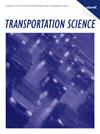大流行期间分布稳健的公平过境资源分配
IF 4.8
2区 工程技术
Q1 OPERATIONS RESEARCH & MANAGEMENT SCIENCE
引用次数: 0
摘要
研究Wasserstein模糊集下的分布鲁棒公平公交资源分配模型(DrFRAM),以优化大流行期间的公共交通资源分配。我们证明了所提出的DrFRAM是高度非凸和非线性的,并且在一般情况下是np困难的。幸运的是,我们表明DrFRAM可以通过利用分布鲁棒优化和单调性的等效表示、二值化整数变量和线性化非凸项,将其重新表述为混合整数线性规划(MILP)。为了改进提出的MILP公式,我们推导了更强的公式,并通过利用模型结构开发了有效的不等式。此外,我们开发了使用不同MILP公式的场景分解方法来解决场景子问题,并引入了一个简单而有效的无左基近似算法,该算法具有可证明的近似保证,可以将模型求解到接近最优性。最后,我们在数值上证明了所提出方法的有效性,并将其应用于由布莱克斯堡运输提供的真实世界数据。历史:本文已被《运输科学与物流新课题》运输科学特刊接受。本工作由计算与通信基础部[Grant 2153607]和民用、机械和制造创新部[Grant 2046426]支持。补充材料:在线附录可在https://doi.org/10.1287/trsc.2022.1159上获得。本文章由计算机程序翻译,如有差异,请以英文原文为准。
Distributionally Robust Fair Transit Resource Allocation During a Pandemic
This paper studies the distributionally robust fair transit resource allocation model (DrFRAM) under the Wasserstein ambiguity set to optimize the public transit resource allocation during a pandemic. We show that the proposed DrFRAM is highly nonconvex and nonlinear, and it is NP-hard in general. Fortunately, we show that DrFRAM can be reformulated as a mixed integer linear programming (MILP) by leveraging the equivalent representation of distributionally robust optimization and monotonicity properties, binarizing integer variables, and linearizing nonconvex terms. To improve the proposed MILP formulation, we derive stronger ones and develop valid inequalities by exploiting the model structures. Additionally, we develop scenario decomposition methods using different MILP formulations to solve the scenario subproblems and introduce a simple yet effective no one left-based approximation algorithm with a provable approximation guarantee to solve the model to near optimality. Finally, we numerically demonstrate the effectiveness of the proposed approaches and apply them to real-world data provided by the Blacksburg Transit. History: This paper has been accepted for the Transportation Science Special Issue on Emerging Topics in Transportation Science and Logistics. Funding: This work was supported by the Division of Computing and Communication Foundations [Grant 2153607] and the Division of Civil, Mechanical and Manufacturing Innovation [Grant 2046426]. Supplemental Material: The online appendix is available at https://doi.org/10.1287/trsc.2022.1159 .
求助全文
通过发布文献求助,成功后即可免费获取论文全文。
去求助
来源期刊

Transportation Science
工程技术-运筹学与管理科学
CiteScore
8.30
自引率
10.90%
发文量
111
审稿时长
12 months
期刊介绍:
Transportation Science, published quarterly by INFORMS, is the flagship journal of the Transportation Science and Logistics Society of INFORMS. As the foremost scientific journal in the cross-disciplinary operational research field of transportation analysis, Transportation Science publishes high-quality original contributions and surveys on phenomena associated with all modes of transportation, present and prospective, including mainly all levels of planning, design, economic, operational, and social aspects. Transportation Science focuses primarily on fundamental theories, coupled with observational and experimental studies of transportation and logistics phenomena and processes, mathematical models, advanced methodologies and novel applications in transportation and logistics systems analysis, planning and design. The journal covers a broad range of topics that include vehicular and human traffic flow theories, models and their application to traffic operations and management, strategic, tactical, and operational planning of transportation and logistics systems; performance analysis methods and system design and optimization; theories and analysis methods for network and spatial activity interaction, equilibrium and dynamics; economics of transportation system supply and evaluation; methodologies for analysis of transportation user behavior and the demand for transportation and logistics services.
Transportation Science is international in scope, with editors from nations around the globe. The editorial board reflects the diverse interdisciplinary interests of the transportation science and logistics community, with members that hold primary affiliations in engineering (civil, industrial, and aeronautical), physics, economics, applied mathematics, and business.
 求助内容:
求助内容: 应助结果提醒方式:
应助结果提醒方式:


